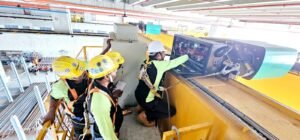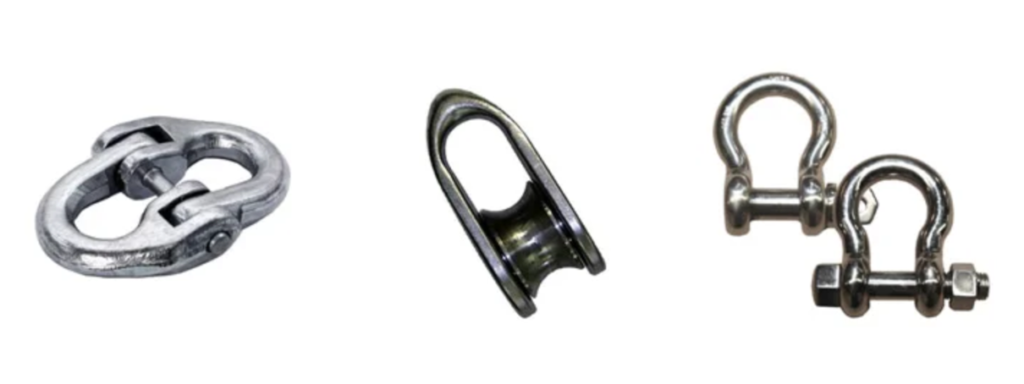Jenmon | Blogs
Shackles and Links Explained: The Underrated Lifting Accessories Behind Every Safe Crane Lift
When considering cranes, you most likely picture gigantic structures handling heavy loads. However, for every safe lift, there are small but essential tools to help with the heavy lifting. Two accessories that you cannot ignore are shackles and links. They will be required to help safely transport the load, keep things stable during the lift, and ensure every lift succeeds. Is your business in construction or logistics? If so, learning about such tools will make your team even more efficient and safe.
What Are Lifting Accessories?
Lifting accessories refer to the tools used to support or join working equipment during lifting. You apply them when carrying, moving, or securing heavy objects. These items might appear to be small in size, but they do big jobs. Some help connect slings to hooks, while others balance the load. Here’s what counts as lifting accessories:
- Shackles
- Links and connectors
- Hooks
- Eyebolts
- Slings and chains
All of them have a role to play in safe lifting. Being fully aware of how and when to utilise them can keep your team safe.
Let’s Talk Shackles—Small Part, Big Job
Shackles connect different lifting parts. They are often used to link slings, chains, or lifting points. They come in different shapes, like bow shackles or D-shackles. A shackle has a pin or bolt that holds everything in place. You’ll find them in steel or alloy versions, depending on the job.
Always check the size and rating before getting them to ensure your equipment stays safe from start to finish.
Where Shackles Shine: Common Applications
Shackles are used in many industries. In construction, they help lift steel beams. In shipping yards, they connect containers to cranes. Shackles also show up in:
- Lifting with webbing or chain slings
- Securing loads on trucks
- Offshore and marine lifting jobs
- Tower crane setups
They are sturdy, convenient, and durable. All you need to do is choose the right type and size according to the job; it is the way to prevent failures in the lifting process.
Links and Connectors: Keeping Everything Together
Links connect lifting chains, slings, or hooks. You’ll often find them in setups with electric hoists or winches. Master links hold multiple legs of a sling. They act as the centrepiece that ties your lift together. You also have connectors, which are compact components designed to make quick and secure joins between lifting chains, hooks, or slings. These lifting accessories must match your load size and setup. If you pick the wrong link, your system could fail. Stick to quality links made from strong metal, and always inspect before each use.
Other Lifting Accessories You Shouldn’t Ignore
Aside from shackles and links, many other lifting accessories support safe crane use. You might use:
- Hooks to grab or lift loads
- Eyebolts to anchor items
- Chain slings for heavy-duty tasks
- Webbing slings for lighter loads
- Pulleys or blocks for balance
Each one has a specific use. Always match the tool to your lifting needs. Keeping spare parts on hand helps, too. A reliable lift setup depends on using the right combination of accessories every time.
How to Choose the Right Lifting Accessories for Your Operation
Choosing the right lifting accessories starts with the load. Know the weight, shape, and where you’re lifting it. Ask these questions:
- What are you lifting?
- How heavy is it?
- Is the shape even or unbalanced?
- Will the item swing or shift during the lift?
Match the accessory to these answers. Use the wrong one, and things may go haywire real quick. Never assume, always verify the load ratings; in uncertain cases, seek advice from a lifting specialist.
Why Specification and Sizing Matter
Size always matters in lifting. A shackle that’s too small won’t hold the load. A link with a low rating can snap. That’s why you must:
- Check the weight capacity
- Choose the correct bolt or pin sizes
- Match sizes with your slings or chains
- Follow the manufacturer’s guidelines
Using lifting accessories that don’t suit your setup puts people at risk. Measure everything first. This way, you prevent mistakes and avoid damage to your crane or load.
Trust a Specialist Like Jenmon for Your Lifting Needs
Jenmon knows lifting. If you need trusty accessories such as shackles, links, or chains, we’ve got what you need. With us, you can obtain equipment that is designed to perform, rugged, proven, and prepared to work in your installation. Whether handling light loads or heavy gear, Jenmon helps you pick the right part. Our team understands your lifting requirements and gives smart suggestions. When you buy from a specialist, you buy with confidence.
Conclusion: It’s the Little Things That Lift the Big Things
Big lifts depend on small parts. Shackles and links might seem irrelevant, but they are important in crane operations. By using the correct accessories, you are reducing risks, which helps you save time. With the right one, you get the job done right.
Choose the right size, the right type, and the right supplier. For help, talk to Jenmon. We’ll make sure your lift starts safely and stays safe.




